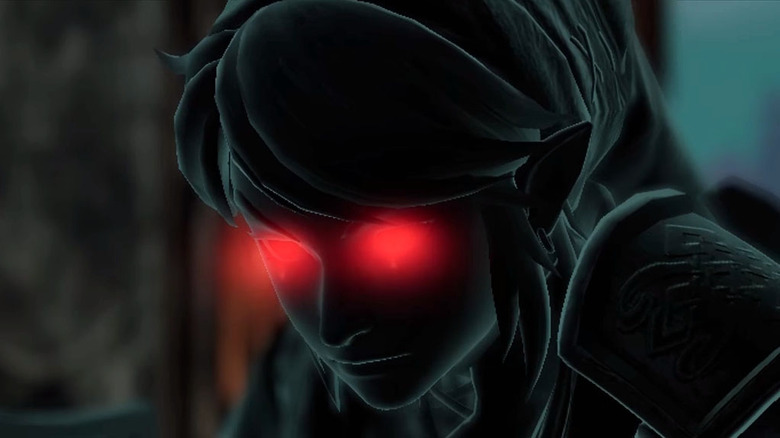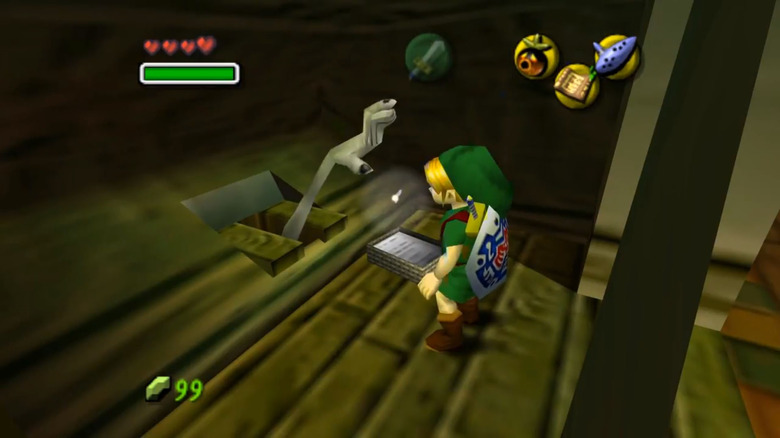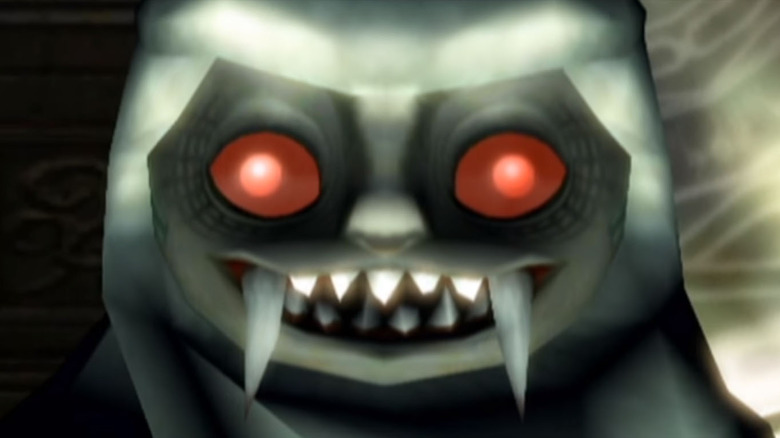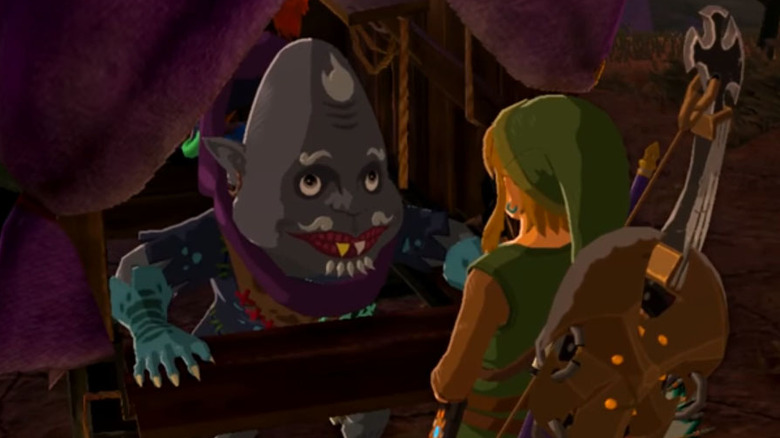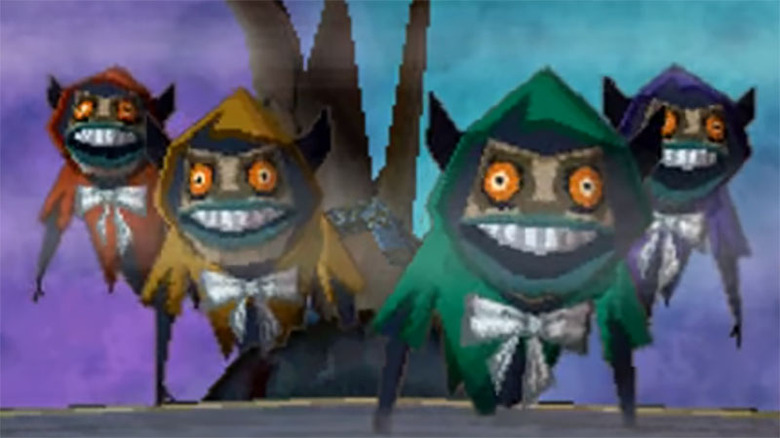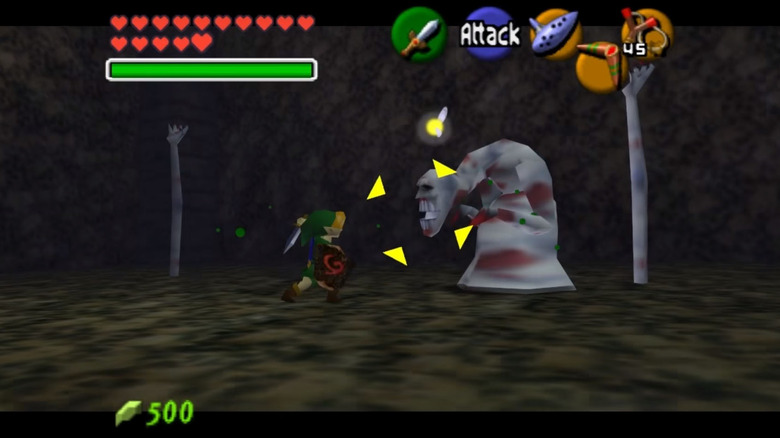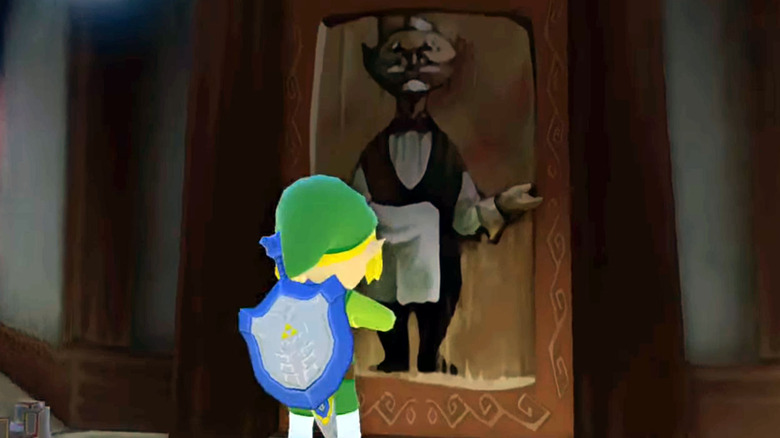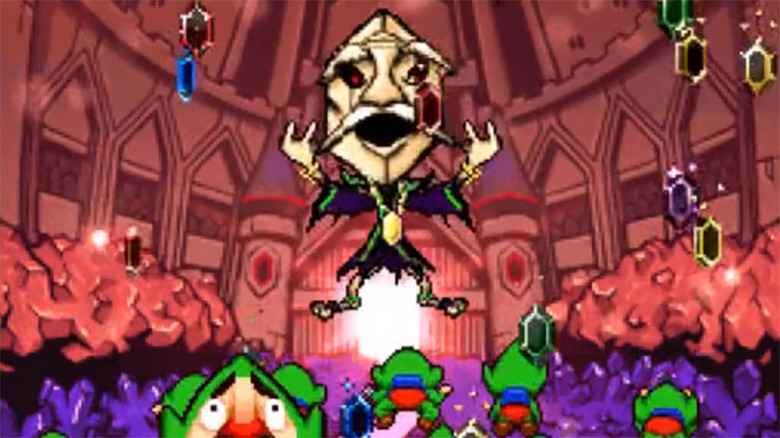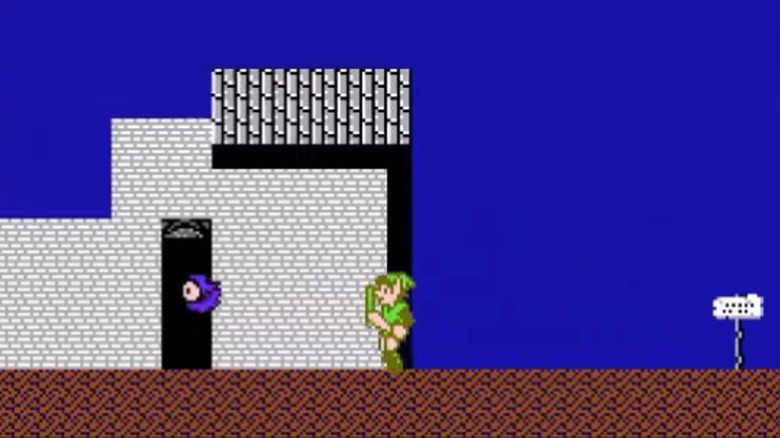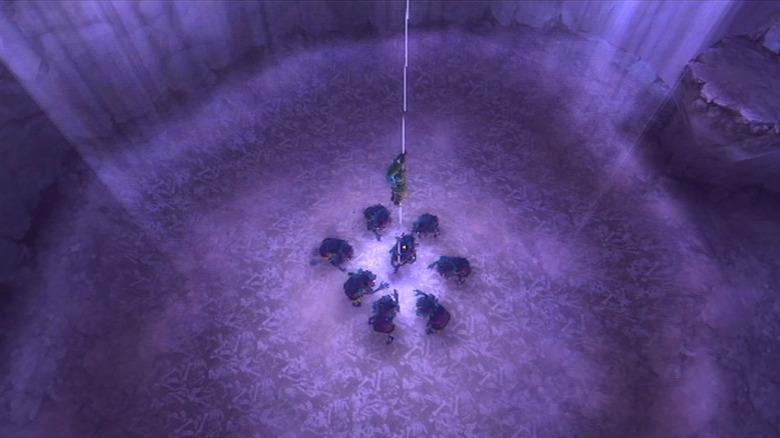The Creepiest Things In The Legend Of Zelda
At first glance, The Legend of Zelda might look like a fantasy adventure in the same vein as The Lord of the Rings, The Neverending Story, Labyrinth, and The Princess Bride. Look a little closer. Once you peel back the layers, you'll see that it has more in common with Friday the 13th, The Ring, The Conjuring, and The Grudge. That's right: underneath that sunny and heroic exterior, the land of Hyrule is full of frightening monsters, eerie dungeons, haunted houses, and cosmic terrors. Zelda isn't always an adventure game. Sometimes, it's an interactive horror flick.
By drawing on both Japanese folklore and popular horror movie tropes, The Legend of Zelda has managed to both shock and delight players for over thirty years. It's weird. It's unsettling. It's very, very creepy, and we love it. The series' occasional detour into full-on horror doesn't just keep things from getting repetitive. It gives Hyrule extra complexity, and helps it stand apart from Middle-earth, Westeros, Narnia, and the rest, and as long as Link, Zelda, Ganon, and the others want to scare us with Zelda's unique brand of chills, we're here for it.
It's safer just to hold it
You're sitting in the bathroom, innocently doing your business, when something reaches up from inside of the toilet and grabs you. Sounds scary, right? Well, in Hyrule, it's just a fact of life. In addition to all other kinds of weirdness, The Legend of Zelda: Majora's Mask introduces Link to "???", also known as the toilet ghost. You can find the spectral voyeur, or at least its bony hand, at the Stock Pot Inn. It asks for paper and repays donors with a piece of heart.
It's all very, very strange, and it gets even weirder once you realize that it has its roots in real-life ghost stories. In an interview with Entertainment Weekly (via Hidden Triforce), Zelda creator Shigeru Miyamoto says, "There are some ghost stories in Japan where — when you are sitting in the bathroom in the traditional style of the Japanese toilet — a hand is actually starting to grab you from beneath." As Miyamoto notes, it's "a very scary story."
He's not wrong. "Hanako of the Toilet," the spirit of a young girl, is often summoned Bloody Mary-style by superstitious school kids. If you head into the bathroom alone and find Hanako answering your questions, expect to find a bloody hand groping you the next time that you use the potty.
But seriously, don't take the mirror
Mirror-based jump-scares are so common in horror films that they've become a cliche, but The Legend of Zelda: Twilight Princess manages to wring some fresh terror out of a tired concept by dropping some light body horror in a place where you'd least expect it. During most of Link's time in the Snowpeak Ruins, Yeta the Yeti seems perfectly harmless. She's sick, you see, and her husband Yeto needs some help making her a comforting bowl of soup. Naturally, Link decides to lend a hand. It's all very sweet and domestic and harmless — until it absolutely is not.
See, Link travels to Snowpeak in search of a Mirror Shard, which he hopes to use to unlock the Twilight Realm. The thing is, Yeta already found it, and she's not giving it up. When Link enters the yetis' bedroom and tries to take the mirror piece for himself, Yeta's waiting for him. She stares at her own reflection and promptly goes full-on Linda Blair, transforming from kindly mythical creature into a fanged, red-eyed monster who screams "NOT TAKE MIRROR." Then, she shatters all of the room's windows with supernatural power and becomes Blizzeta, a "Twilight Ice Mass" that Link must fight.
Of course, after the ordeal, Yeta is herself again, and later she challenges Link to some perfectly innocent sledding races. It's like nothing bad happened. We know better, though. Whisper "NOT TAKE MIRROR" to any die-hard Zelda fan and watch them tremble with fear.
Jason, eat your heart out
The right mask can turn a mediocre horror villain into a great one. There's a reason why Jason Voorhees, Michael Myers, and Leatherface all wear one. The Legend of Zelda: Majora's Mask, however, takes facial disguises to the next level. Not only are the game's magical masks a big part of what makes that game so creepy, but the Happy Mask Salesman regularly tops lists of the all-time most disturbing Zelda characters.
So, when masks showed up in Breath of the Wild, seasoned Zelda players felt a well-earned tingle travel up their spines. They weren't disappointed. Kilton isn't as overtly sinister as the Happy Mask Salesman, but talk to him a few times, and red flags start to appear. He only shows up at night. He thinks that Fang and Bone is a great name for a shop, and he only trades in black market monster organs. Then, you see his wares. Guess what Kilton sells? That's right. It's the Happy Mask Salesman all over again.
Kilton's masks, which let you disguise yourself as various enemies, aren't as inherently creepy as the ones in Majora's — at least, not until you get too close to your prey. Try wearing a lizalfos mask around one of the lizard-like warriors. They'll follow you around, eye you suspiciously, and lick your face. It's creepy, unsettling, and gross — but, then again, this is Zelda. Any time masks show up, things are going to get weird. That's just how it goes.
Sugar and spice and everything not-so-nice
Here's a tip for surviving The Legend of Zelda's most unsettling moments: if it looks cute, it's probably going to try to kill you. Take The Phantom Hourglass' Cubus Sisters, for example. When you first run across them, they look harmless. Don't be fooled. After all, if The Shining has taught us anything, it's that little girls who hang out in haunted locations are definitely up to no good.
C'mon. You find the Cubus Sisters lurking on board a ghost ship. That's warning sign number one. They also give Link bad information, directing him to chests that contain deadly foes and telling him not to shoot the evil Reaplings from behind, which turns out to be the only way to slow them down. That's warning sign number two. Worst of all? When you finally get all of the Cubus Sisters together in one place, they shed their mortal guises, show their demonic faces, and attack Link with their black magic. So, yeah. Warning sign number three.
The following battle isn't difficult, but by that point, the damage has been done. There's a reason why little girls pop up in horror flicks all the time, and after exiting The Phantom Hourglass' ghost ship, we wouldn't blame you if you never helped a child in need ever again.
All's well that ends (in the) well
Players seem to agree that The Legend of Zelda: Ocarina of Time's Shadow Temple is the game's most disturbing dungeon. It's hard to argue: it's entrance is found in a graveyard. It's decorated with blood stains and torture devices. False walls and hidden passageways are everywhere, the temple is filled to the brim with all kinds of undead nasties, and its final boss is a giant eye and two severed hands. You want nightmares? Yeah, that'll do it.
But let's give a little love to the Shadow Temple's childhood-era equivalent, the Bottom of the Well, too. The Well might be an optional dungeon, and it's not nearly as big as its adult equivalent. That doesn't make it any less scary, however. That just means that the Bottom of the Well features more frights per square foot. Like the Shadow Temple, the Bottom of the Well is home to lumbering ReDeads, claw-like Wallmasters, creeping Skulltulas, and the Dead Hand, a zombie-like creature that uses disembodied hands to grab and consume its prey.
There's more to the Well than that, though. For one, it's got an odd and mysterious backstory — at some point, a man who lived on the same plot of land had the power of second sight. But it's the Bottom of the Well's decorations that really sell sell the horror. Not only is the Bottom of the Well home to various coffins and caskets, but look carefully at the plants. That's not vegetation. Those are human arms scattered on the floor. So, yeah. Gross.
A nice place to visit, but we wouldn't want to live there
You know what would make sailing The Legend of Zelda: Wind Waker's wide-open seas even better? An island bungalow to retire to after a busy day in the ocean air. Well, play your cards right, and Link can get just that. For a mere 20 Heart Pendants, Windfall Island's beleaguered school teacher, Mrs. Marie, will hand Link the deed to her tropical getaway, which can be found on the aptly named Private Oasis.
At first, Link's cabana looks like the perfect place for a harried adventurer to kick back and relax. It would be, too, if it wasn't hella haunted. The first sign of trouble comes when Link decides to enter the house, only to learn that his new butler isn't a person at all. He's some kind of supernatural caretaker who only appears on the front door and on various cutouts scattered around the cabin. Then, Link uses the Hookshot to reveal a hidden passage in the fireplace — no, that's not ominous at all — that leads to the basement.
That's where the real horror show begins. The cabana's lower level is filled with infected rats, ReDeads (i.e. the Zelda universe's zombie equivalent), and rare treasure. Add in the way that the butler constantly sets up puzzles for Link to solve despite the fact that he's got no corporeal form, and you've got less of a vacation home, and more of a haunted house. Get in, get your Triforce Chart, then get as far away as you can. It's the only truly safe option.
Your rupee-sense is tingling
Yes, Tingle is creepy. There's no other way to put it. Tingle is a 35-year-old man who dresses like a teenage hero, thinks he's a fairy, has a pretty severe Peter Pan complex, wears a skin-tight green leotard, and rides around on balloons.
Tingle might be annoying, but surprisingly, his off-the-charts creep-factor isn't actually his fault. As revealed in Tingle's spin-off title, Freshly-Picked: Tingle's Rosy Rupeeland, Tingle is actually a victim. Freshly-Picked: Tingle's Rosy Rupeeland introduces players to the deceptively evil Uncle Rupee, a demon who needs Hyrule's most commonly used currency, rupees, to grow in power. When the game begins, Uncle Rupee offers our hero — who's just a regular guy — a life in paradise in exchange for the valuable gems. The main character agrees, and Rupee transforms him into one of many Tingles, then forces him to do whatever Uncle Rupee asks.
Oh, and that labor-free wonderland that Uncle Rupee's promising? It's basically hell. Rupeeland might sound fun, but a quick vision of what Uncle Rupee has in store will change your mind very quickly. Comedically presented as its own game, Bad Uncle Rupee's Ashen Rupeeland is a desolate and barren world ruled over by Uncle Rupee, one where all of the previous Tingles serve as Uncle Rupee's slaves. Even worse, if Uncle Rupee gets his way, that's what all of Hyrule is going to look like. Tingle might be odd, but Uncle Rupee is a downright madman — so hey! At least Tingle comes by his creepiness honestly.
Zelda's original ghost town
Creepy Zelda isn't a new thing. The series has been a healthy source of nightmare fuel from the very beginning. The Legend of Zelda introduced morbid franchise staples like grave robbing, while its sequel, Zelda II: The Adventure of Link, ups the ante with Old Kasuto, one of the most effectively unsettling locations in Zelda history. Immediately upon entering Old Kasuto, it's clear that something's off. Most of The Adventure of Link's villages are bustling with activity. Old Kasuto is abandoned. Its buildings are crumbling, and its citizens have fled thanks to the invading Moas, or monstrous flying eyeballs. Only one man stayed behind, hiding underground to warn travelers about Old Kasuto's many dangers.
The most frightening part, though? Unless you possess the Cross, you won't be able to see the Moas when you enter Kasuto's remains. They'll still attack you. You just won't be able to fight back. Essentially, stepping into Kasuto unprepared — which is exactly what you're going to do the first time that you play the game — condemns Link to a sudden, haunting, and entirely unexplained demise. It might be quaint by today's standards, but back in the good ol' days, Old Kasuto's quiet eeriness was about as scary as video games could get. It's no wonder that everyone left. Even properly equipped, we don't really like hanging around in Old Kasuto, either.
Dangling by a thread
If The Legend of Zelda: Skyward Sword's Ancient Cistern doesn't give you chills then you probably don't know its backstory. While many Zelda characters and settings are inspired by folklore and mythology, literate Zelda players have figured out that the Ancient Cistern is direct adaptation of a story by the troubled writer Ryūnosuke Akutagawa, the man best known as the author of "Rashomon" and "Hell Screen."
In the tale "The Spider's Thread", the Buddha walks through Paradise and glances into a pond, glimpsing Hell below. In Hell, Buddha sees a notorious thief named Kandata, who's suffering for his mortal crimes. Kandata isn't all bad, though: once he decided not to squish a spider. For that one good deed, Buddha decides to rescue him. Buddha sends a spider into Hell, which leaves a strand of webbing behind it, and Kandata quickly uses the thread to climb out of his prison. However, when Kandata looks down, he sees thousands of other sinners clawing their way after him. Afraid that that the thread will break, Kandata yells at them to stop. His lack of empathy makes the strand snap, and Kandata loses his freedom, careening back into the Lake of Blood below.
Now, go play through The Ancient Cistern again. Seem familiar? A giant Buddha statue lords over the dungeon, while the poisonous pools and sharp obstacles recall the story's Lake of Blood and Mountain of Needles. Then, of course, there's the centerpiece: in order to escape the dungeon, Link must scramble up a rope while hordes of Bokoblins follow behind.

